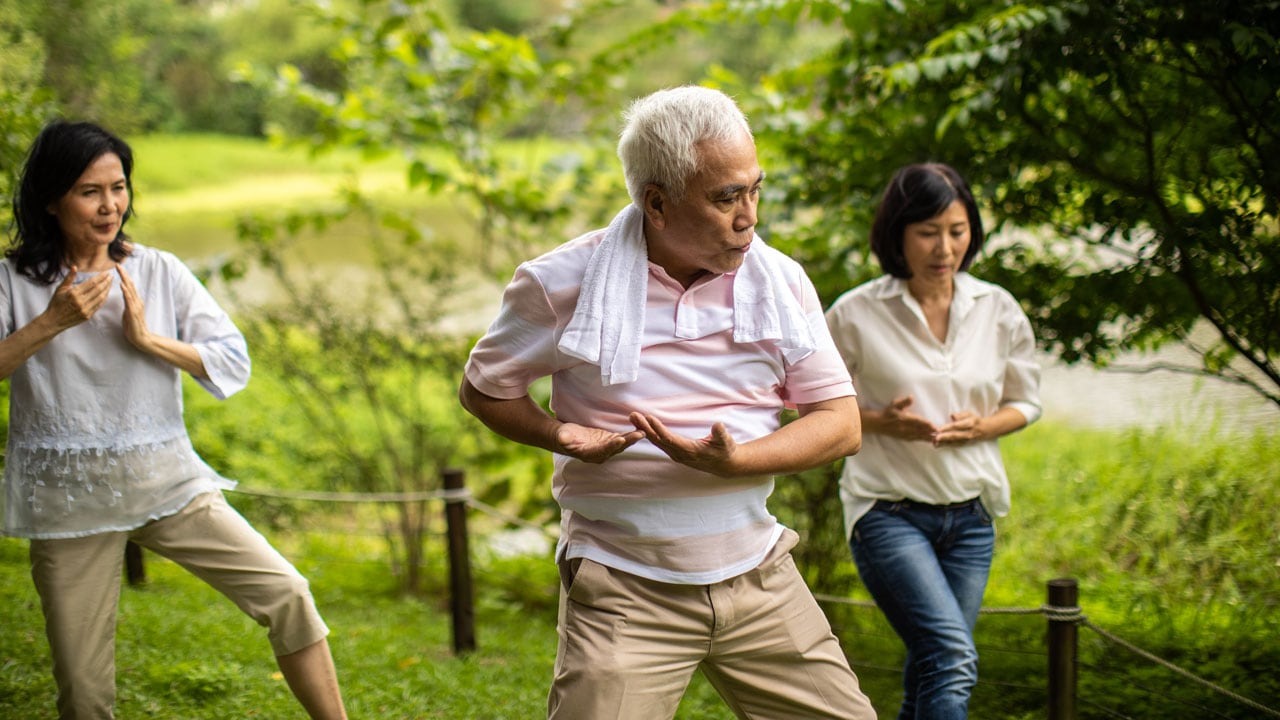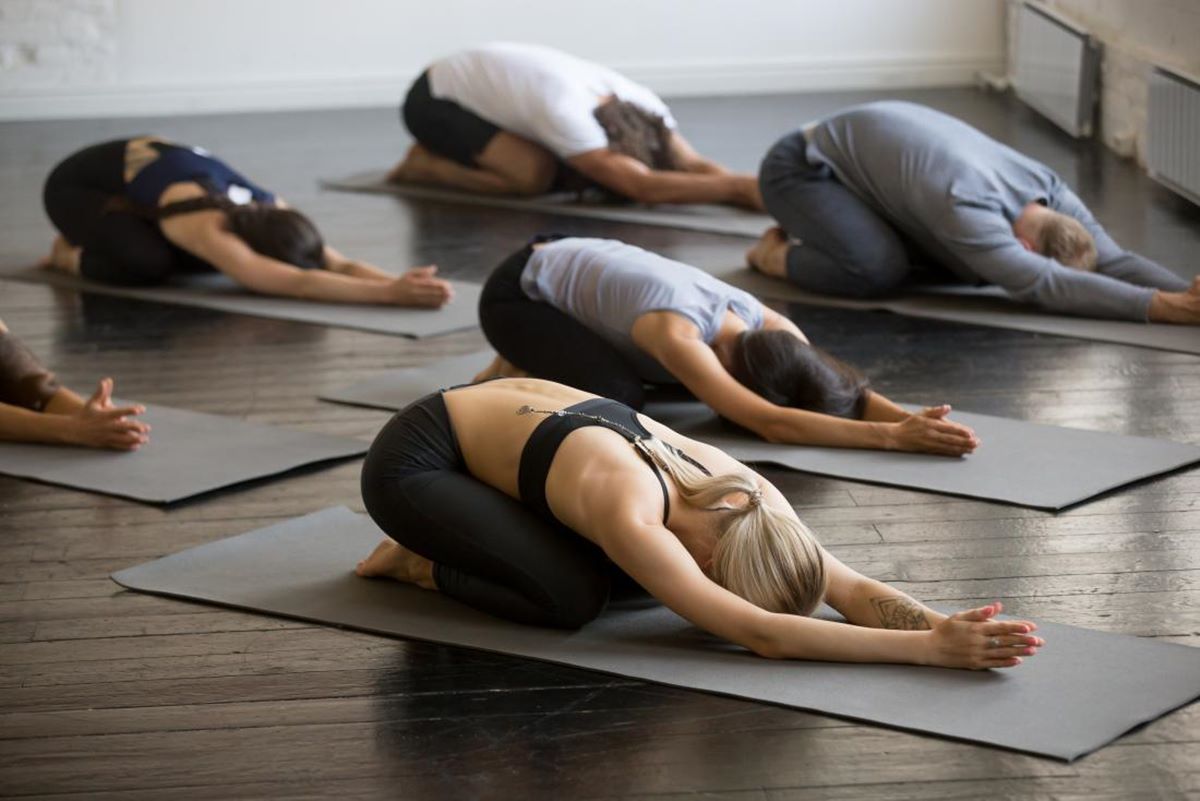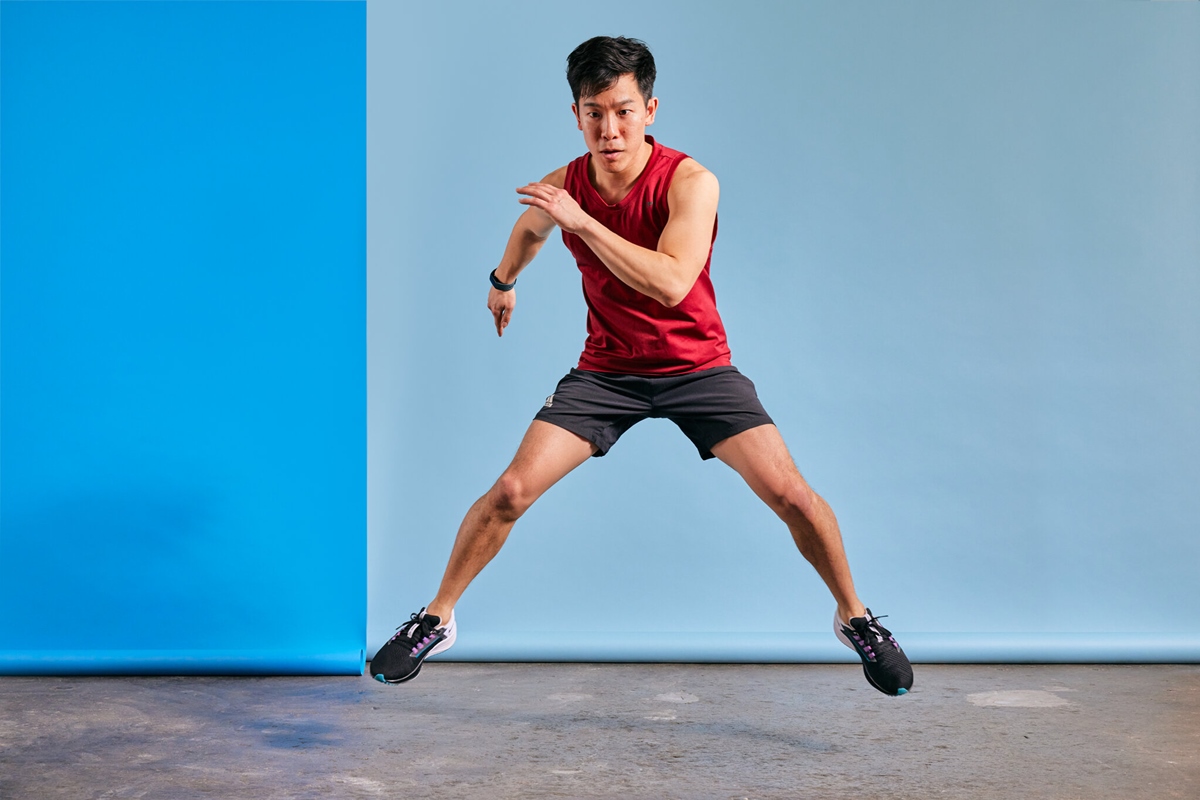

Featured
What Is Qigong Exercise
Modified: January 2, 2024
Learn more about the benefits of Qigong exercise and how it can improve your overall well-being. Discover featured practices and techniques for a healthier mind and body.
Introduction
Welcome to the world of Qigong exercise! Whether you are new to the concept or have already heard about it, this article will provide you with a comprehensive understanding of this ancient and powerful practice. Qigong exercise, pronounced “chee-gong,” is a holistic approach to health and well-being that originated in ancient China.
Qigong exercise encompasses a wide range of techniques and practices that integrate physical postures, breathing techniques, and focused intention to cultivate and balance the body’s vital energy, or Qi. The word “Qi” translates to “life force” or “energy” in English, and “gong” means “work” or “cultivation.” Thus, Qigong exercise can be understood as the cultivation and refinement of one’s vital energy.
Qigong exercise is deeply rooted in Chinese philosophy and traditional medicine, drawing inspiration from concepts such as Yin and Yang, the Five Elements, and the meridian system. These principles form the foundation of Qigong exercise, guiding practitioners to harmonize and optimize their energy flow to achieve physical, mental, and spiritual well-being.
One of the remarkable aspects of Qigong exercise is its accessibility to people of all ages and fitness levels. Unlike many intense physical exercises that require strength and endurance, Qigong exercise is gentle, graceful, and can be modified to accommodate individual needs and limitations.
The benefits of Qigong exercise are vast and wide-ranging. Regular practice of Qigong exercise can help improve physical health by strengthening the immune system, enhancing flexibility and balance, and reducing chronic pain. It also promotes mental well-being by reducing stress, anxiety, and depression, improving focus and mental clarity, and enhancing overall emotional balance.
Through its emphasis on mindfulness and deep breathing, Qigong exercise connects the mind, body, and spirit, fostering a sense of inner peace, tranquility, and self-awareness. Additionally, Qigong exercise is a valuable tool for preventive health care, helping individuals maintain optimum health and vitality.
In the following sections, we will delve deeper into the origins, philosophical principles, techniques, and practices of Qigong exercise. We will also provide guidance on how to start practicing Qigong exercise and highlight precautions and safety measures. By the end of this article, you will have a solid foundation of knowledge to embark on your Qigong exercise journey.
Definition of Qigong Exercise
Qigong exercise can be defined as a system of integrated body movements, breath control, and mental focus that aims to cultivate and balance the body’s vital energy, or Qi. The concept of Qi is fundamental to Chinese philosophy and medicine and refers to the life force or energy that flows through all living beings.
In Qigong exercise, the emphasis is placed on cultivating, circulating, and harmonizing Qi within the body. It is believed that when Qi flows smoothly and abundantly, health and well-being are enhanced, while blockages or imbalances in Qi can lead to illness and disease.
Qigong exercise involves various components that work together to optimize the flow of Qi. These components include physical postures, gentle movements, breathing techniques, visualization, and meditation. By engaging in these practices, individuals can enhance their Qi, strengthen their internal organs, and achieve a state of balance and harmony.
One of the distinguishing features of Qigong exercise is its focus on intention and mindfulness. Practitioners are encouraged to cultivate a deep awareness of their body, breath, and mind during the practice. This heightened awareness allows for the cultivation of Qi and the release of any stagnant or blocked energy within the body.
There are numerous styles and forms of Qigong exercise, ranging from slow and meditative to more dynamic and vigorous. Some forms of Qigong exercise are rooted in martial arts traditions, while others are centered around healing and therapeutic purposes. Regardless of the style, the underlying goal remains the same – to cultivate and balance Qi for optimal health and well-being.
It is important to note that Qigong exercise is not just a physical exercise; it is a holistic practice that encompasses the physical, mental, and spiritual dimensions of a person. It goes beyond the superficial and aims to create a deep connection between the individual and the universal energy.
In the next section, we will explore the fascinating origins of Qigong exercise and how it has evolved throughout history.
Origins of Qigong Exercise
The origins of Qigong exercise can be traced back thousands of years to ancient China. The practice has deep roots in the country’s rich cultural and philosophical traditions, including Taoism, Confucianism, and Traditional Chinese Medicine (TCM).
Qigong exercise emerged as a way to harmonize and balance the body’s vital energy, known as Qi, in order to maintain health and prevent disease. It was initially developed by Taoist adepts who sought longevity, vitality, and spiritual enlightenment through the cultivation of Qi.
Ancient texts such as the “Yellow Emperor’s Classic of Internal Medicine” and the “Daoist Canon” contain references to various Qigong exercises and their therapeutic benefits. These texts describe practices that involve movements, breath control, and meditation to enhance the flow of Qi and promote overall well-being.
Over the centuries, Qigong exercise evolved and spread throughout China, adapting and merging with different philosophical and medical systems. It became a widely practiced discipline among scholars, monks, martial artists, and the general population.
During the Cultural Revolution in China in the mid-20th century, Qigong exercise experienced a period of suppression as anything closely associated with traditional Chinese culture was discouraged. However, it experienced a resurgence in the 1980s when the Chinese government recognized the immense health benefits of the practice and officially supported its promotion.
Today, Qigong exercise has gained popularity not only in China but also around the world. It has become a recognized form of exercise and therapy, offering a holistic approach to health and well-being.
It is worth highlighting that Qigong exercise is deeply connected to other Chinese martial arts practices, such as Tai Chi, which also incorporate the cultivation of Qi. While Tai Chi focuses on slow and flowing movements, Qigong exercise encompasses a broader range of practices that can be classified into different styles, including medical, martial, spiritual, and self-cultivation.
The transmission of Qigong exercise knowledge has been predominantly passed down through lineages, with masters imparting their teachings to dedicated disciples. Nowadays, Qigong exercise is also accessible through books, videos, and organized classes led by experienced instructors.
In the following section, we will explore the philosophical principles that underlie the practice of Qigong exercise, offering a deeper understanding of its underlying concepts.
Philosophical Principles of Qigong Exercise
Qigong exercise is deeply rooted in ancient Chinese philosophy and draws upon several fundamental principles that guide its practice. These principles provide a philosophical framework for understanding the human body, the flow of energy, and the cultivation of Qi.
One of the key principles is the concept of Yin and Yang, which symbolizes the dualistic nature of the universe. Yin represents the passive and receptive aspects, while Yang represents the active and dynamic aspects. In Qigong exercise, practitioners seek to balance the Yin and Yang energies within themselves, harmonizing their internal and external environments.
Another essential principle in Qigong exercise is the theory of the Five Elements, which associate various aspects of nature and the human body with five elements: Wood, Fire, Earth, Metal, and Water. Each element corresponds to specific organs, emotions, colors, and seasons. By understanding and harmonizing these elements within the body, practitioners can nurture their overall well-being.
The concept of Qi, or vital energy, is central to Qigong exercise. Qi is believed to flow through meridians or energy channels in the body. By cultivating and harmonizing the flow of Qi, practitioners can enhance their physical, mental, and spiritual health. Qi is also closely linked to the breath, with practices involving specific breathing techniques to regulate and guide the flow of Qi throughout the body.
Mindfulness and intention are core principles in Qigong exercise. Practitioners are encouraged to cultivate a deep sense of presence and awareness during the practice, focusing their attention on the movements, the breath, and the sensations within the body. Through this heightened awareness, practitioners can facilitate the free flow of Qi and cultivate a state of inner calm and tranquility.
Additionally, Qigong exercise incorporates the concept of Dao, which translates to “the way” or “the path.” It refers to the natural order and flow of the universe. By aligning with the Dao and following its principles, practitioners can cultivate harmony with nature and tap into the infinite wisdom and energy of the universe.
These philosophical principles not only provide a conceptual understanding of Qigong exercise but also serve as a guide to living a balanced and harmonious life. The practice of Qigong exercise offers a profound opportunity for self-reflection, self-awareness, and self-transformation.
As we continue exploring Qigong exercise, we will delve into the diverse benefits that a regular practice can offer to individuals seeking to enhance their physical and mental well-being.
Benefits of Qigong Exercise
Qigong exercise offers a multitude of benefits for the mind, body, and spirit. With regular practice, individuals can experience improvements in physical health, mental well-being, and overall quality of life.
One of the primary benefits of Qigong exercise is its ability to reduce stress and promote relaxation. The slow, gentle movements coupled with deep breathing and focused attention help to calm the mind, release tension, and alleviate anxiety. Regular practice can lead to improved sleep quality, increased feelings of inner peace, and a greater ability to handle stressors in daily life.
Qigong exercise also has a positive impact on physical health. It promotes flexibility, strength, and balance, improving overall body coordination. Regular practice can help to alleviate chronic pain, boost the immune system, and enhance the function of internal organs. It is particularly beneficial for individuals with conditions such as arthritis, cardiovascular disease, respiratory issues, and digestive disorders.
The cultivation of Qi through Qigong exercise has been shown to boost energy levels and vitality. The harmonization of the body’s energy flow leads to increased stamina and a greater sense of well-being. Individuals often report improved focus, mental clarity, and heightened creativity as the mind becomes clearer and more balanced.
Qigong exercise is also known for its positive effects on emotional well-being. Regular practice can help to release negative emotions and cultivate positive attitudes. It promotes self-awareness and introspection, allowing individuals to develop a greater understanding of their emotions and how to manage them effectively. It can also improve relationships, as individuals become more empathetic and emotionally attuned.
Additionally, Qigong exercise has shown promising results in supporting immune function. It helps to balance the body’s energy and enhance the body’s natural healing abilities. This makes it a valuable practice for preventive health care, reducing the risk of illnesses and supporting overall immune health.
Furthermore, the meditative aspect of Qigong exercise provides an opportunity for spiritual growth and self-discovery. The practice helps individuals connect with their inner selves and cultivate a greater sense of purpose and meaning in life. It fosters a deep connection with nature and the surrounding environment, leading to a greater sense of harmony and interconnectedness.
It is important to note that the benefits of Qigong exercise are cumulative and develop over time with consistent practice. It is recommended to seek guidance from experienced instructors to ensure proper technique and maximize the benefits.
Now that we have explored the benefits of Qigong exercise, let’s dive into the different types and styles of Qigong exercise that exist.
Types of Qigong Exercise
Qigong exercise encompasses a wide range of styles and techniques, each with its own unique characteristics and focus. While there are numerous variations and subdivisions, Qigong exercise can generally be categorized into two main types: Dynamic Qigong and Static Qigong.
Dynamic Qigong involves fluid and rhythmic movements that are performed in a continuous and flowing manner. These movements are often inspired by the natural world, imitating the graceful movements of animals, birds, or even elements like water and wind. Dynamic Qigong exercises are designed to promote physical strength, flexibility, and the circulation of Qi. Examples of Dynamic Qigong include the popular practice of Tai Chi, as well as Ba Duan Jin or the Eight Silk Brocade.
Static Qigong, on the other hand, involves holding specific postures or positions for an extended period of time. These postures may be standing, sitting, or lying down, and they allow for deep relaxation and concentration. Static Qigong exercises focus on the cultivation and regulation of Qi within the body, enhancing internal strength, and balancing the flow of energy. Popular examples of Static Qigong include Zhan Zhuang (Standing Meditation) and Wuji Qigong (Primordial Qigong).
Within these broad categories, there are numerous styles and forms of Qigong exercise, each with its own emphasis and specific techniques. For example, Medical Qigong focuses on healing and restoring balance in the body, using specific movements, breathing techniques, and meditation to address specific health conditions. Martial Qigong incorporates Qigong exercises into martial arts training to enhance physical strength, flexibility, and combat skills.
Spiritual Qigong is practiced with the intention of cultivating spiritual growth and deepening one’s connection with the inner self and the universe. It often involves visualization, chanting, and energy work to increase awareness and expand consciousness. Self-cultivation Qigong focuses on personal growth and self-improvement, emphasizing mindfulness, self-reflection, and the development of virtues like patience, compassion, and humility.
It’s important to note that while the categorization of Qigong exercise into types can be helpful for understanding different practices, there is often overlap and integration between styles. Many practitioners incorporate elements from various types of Qigong into their practice, tailoring it to their own needs and preferences.
Now that we have explored the different types of Qigong exercise, let’s delve into the techniques and practices commonly used in Qigong exercise.
Techniques and Practices in Qigong Exercise
Qigong exercise encompasses a myriad of techniques and practices that aim to cultivate and balance Qi, the body’s vital energy. These techniques can be categorized into three main aspects: body movements, breathing techniques, and mental focus.
Body Movements: Qigong exercise involves a variety of gentle and flowing movements that are performed with grace and intention. These movements are designed to stimulate the flow of Qi, stretch and strengthen the body, and enhance overall flexibility and balance. They often incorporate elements inspired by nature and animals, such as the swaying of trees, the flowing of water, or the gracefulness of birds. The movements are performed slowly and smoothly, allowing practitioners to cultivate mindfulness and deepen their connection with the body.
Breathing Techniques: Proper breathing is a fundamental aspect of Qigong exercise. It is believed that conscious and controlled breathing helps to regulate the flow of Qi and calm the mind. Qigong exercises incorporate various breathing techniques, such as abdominal breathing, reverse breathing, or deep diaphragmatic breathing. By synchronizing the breath with the movements, practitioners enhance their awareness of Qi and facilitate its circulation throughout the body. Deep and relaxed breathing helps to replenish Qi and release tension, promoting relaxation and a sense of well-being.
Mental Focus: The mental aspect of Qigong exercise is crucial for harnessing the full benefits of the practice. Practitioners are encouraged to cultivate a deep sense of mindfulness and intention during the exercise. Focusing the mind on the present moment and the sensations within the body helps to deepen the connection with Qi. Visualization techniques are also employed in Qigong exercise, where practitioners imagine the flow of Qi within their body or visualize qualities such as vitality, healing, or harmony. This mental focus enhances the effectiveness of the practice and supports the cultivation and harmonization of Qi.
In addition to these core techniques, Qigong exercise often incorporates other practices such as meditation, self-massage, and acupressure. Meditation allows for a deeper exploration of inner awareness and tranquility, fostering a sense of calmness and clarity. Self-massage techniques, known as “Qi self-massage,” involve gentle rubbing or tapping of specific acupoints or energy channels to promote the flow of Qi and release blockages. Acupressure techniques involve applying gentle pressure to specific points on the body to stimulate the flow of Qi and alleviate discomfort or pain.
It is important to note that Qigong exercise is a highly personal practice, with individuals often customizing their techniques and practices based on their specific needs and preferences. Some practitioners may focus more on the physical aspect of Qigong exercise, while others may emphasize the meditative and spiritual aspects. The key is to find a balance that resonates with one’s own journey of self-discovery and well-being.
In the next section, we will explore how to start practicing Qigong exercise and provide guidance for beginners.
How to Start Practicing Qigong Exercise
If you are interested in starting your journey into the practice of Qigong exercise, here are some steps to help you get started:
1. Find a Qualified Instructor:
Seek out a qualified Qigong instructor or master who can guide you through the fundamentals of the practice. Look for someone with experience and knowledge in the specific style or form of Qigong exercise you are interested in. They will be able to provide proper instruction, ensure correct posture and technique, and offer guidance as you progress in your practice.
2. Set Aside Regular Practice Time:
Consistency is key when practicing Qigong exercise. Set aside dedicated time each day to engage in your practice. Even starting with just 10-15 minutes a day can be beneficial. As your practice becomes more established, you can gradually increase the duration of your sessions.
3. Create a Calm and Harmonious Environment:
Find a quiet and peaceful space where you can practice without distractions. It can be indoors or outdoors, as long as it provides a calm and harmonious atmosphere. You may want to play soft, soothing music or use natural elements like candles or incense to enhance the ambiance.
4. Warm-Up and Stretch:
Before delving into the main exercises, it is important to warm up your body and prepare it for the movements. Engage in some gentle stretching to loosen your muscles and joints. This will help prevent injuries and promote greater flexibility and range of motion.
5. Start with Basic Movements:
Begin with simple Qigong exercises that focus on basic movements, such as gentle arm swings, waist rotations, or leg stretches. These foundational movements help to activate the flow of Qi and familiarize you with the principles of Qigong exercise. Gradually progress to more complex and challenging movements as you gain confidence and experience.
6. Practice Proper Breathing Techniques:
Concentrate on your breathing throughout the practice. Practice deep diaphragmatic breathing, allowing your abdomen to rise and fall with each breath. Coordinate your breath with the movements, inhaling as you expand and exhaling as you contract. This synchronized breathing will help guide the flow of Qi and promote relaxation and mindfulness.
7. Focus on Mindfulness and Intention:
As you perform the exercises, bring your attention to the present moment and stay fully present with each movement and breath. Cultivate an intention for your practice, whether it is to improve your health, find inner peace, or cultivate self-awareness. Visualize the flow of Qi within your body and connect with the sensations and energy that arise during the practice.
8. Take It Slow and Listen to Your Body:
Qigong exercise is a gentle and non-competitive practice. Take it at your own pace and honor the limitations of your body. If you feel any discomfort or pain, modify the movements or consult with your instructor. Remember that Qigong exercise is about listening to and honoring your body’s needs.
With these steps, you can begin your journey into the practice of Qigong exercise. Remember to be patient and enjoy the process. As you continue to practice, you will reap the numerous benefits that Qigong exercise has to offer.
In the next section, we will explore important precautions and safety measures to keep in mind while practicing Qigong exercise.
Precautions and Safety Measures in Qigong Exercise
While Qigong exercise is generally safe for people of all ages and fitness levels, it is important to keep certain precautions in mind to ensure a safe and effective practice. Here are some key precautions and safety measures to consider:
1. Consult with a Healthcare Professional:
If you have any underlying health conditions or concerns, it is advisable to consult with your healthcare professional before starting a Qigong exercise practice. They can provide guidance and ensure that Qigong exercise is suitable for your specific needs and medical history.
2. Practice within Your Physical Limits:
Listen to your body and practice within your physical limits. Avoid pushing yourself too hard or overexerting yourself. Gradually increase the intensity and duration of your practice as you build strength and flexibility. If you experience pain or discomfort during the practice, make modifications or rest as needed.
3. Warm-Up and Cool Down:
Always incorporate a warm-up and cool-down period into your Qigong exercise routine. This helps to prepare your body for the movements and prevents muscle strain or injury. Gentle stretching, joint rotations, and light aerobic exercises are recommended as part of the warm-up and cool-down processes.
4. Stay Hydrated:
Drink water before, during, and after your Qigong exercise sessions to stay hydrated. This is particularly important if you are practicing outdoors or in hot and humid conditions. Adequate hydration supports your overall well-being and helps to maintain the flow of energy in the body.
5. Practice in a Safe Environment:
Choose a safe and spacious environment to practice Qigong exercise. Ensure that the area is free from obstacles or hazards that may cause accidents. If you practice outdoors, be mindful of the terrain, weather conditions, and any potential hazards.
6. Use Proper Body Alignment:
Pay attention to your posture and body alignment during the practice. Maintaining proper alignment helps to prevent strain on the joints and muscles. Keep your spine straight, relax your shoulders, and engage your core muscles to support your movements.
7. Respect Your Energy Levels:
Qigong exercise should leave you feeling energized and rejuvenated. If you feel excessively tired, fatigued, or dizzy during or after the practice, it may be a sign that you are overexerting yourself. Take breaks as needed and adjust the intensity of your practice to match your energy levels.
8. Seek Guidance from a Qualified Instructor:
Working with a qualified Qigong instructor is crucial, especially for beginners. They can provide proper guidance on technique, posture, and breathing, as well as ensure that you are practicing safely and effectively. They can also offer modifications or adjustments based on your individual needs and limitations.
By following these precautions and safety measures, you can experience a safe and enjoyable Qigong exercise practice. Always remember to listen to your body and respect its limits throughout your journey.
In the concluding section, we will summarize the key points discussed in this article and emphasize the value and potential of Qigong exercise in enhancing overall health and well-being.
Conclusion
Qigong exercise is a profound practice that offers a holistic approach to health and well-being. Rooted in ancient Chinese philosophy and traditional medicine, Qigong exercise combines gentle body movements, mindful breathing, and focused intention to cultivate and balance the body’s vital energy, known as Qi.
The benefits of practicing Qigong exercise are vast and encompass various aspects of health and wellness. Regular practice can reduce stress, enhance relaxation, improve physical fitness, boost mental clarity, and promote emotional balance. It provides a powerful tool for maintaining optimum health and preventing illness by optimizing the flow of Qi within the body.
With its diverse types and styles, Qigong exercise caters to a wide range of individuals. Whether you are looking to improve your physical fitness, manage stress, cultivate mindfulness, or deepen your spiritual connection, there is a form of Qigong exercise that can resonate with you.
When starting your Qigong exercise journey, it is important to find a qualified instructor who can guide you through the proper techniques and practices. Consistency and patience are key as you gradually integrate Qigong exercise into your daily routine. Remember to listen to your body, respect its limits, and practice with mindfulness and intention.
As you embrace the practice of Qigong exercise, you may discover its transformative power, not only on a physical level but also on a mental, emotional, and spiritual level. It offers an opportunity to cultivate inner peace, balance, and a deeper connection with yourself and the world around you.
So, take a breath, center yourself, and embark on your Qigong exercise journey. Explore the movements, embrace the mindfulness, and let the flow of Qi guide you towards a healthier, more harmonious life.









